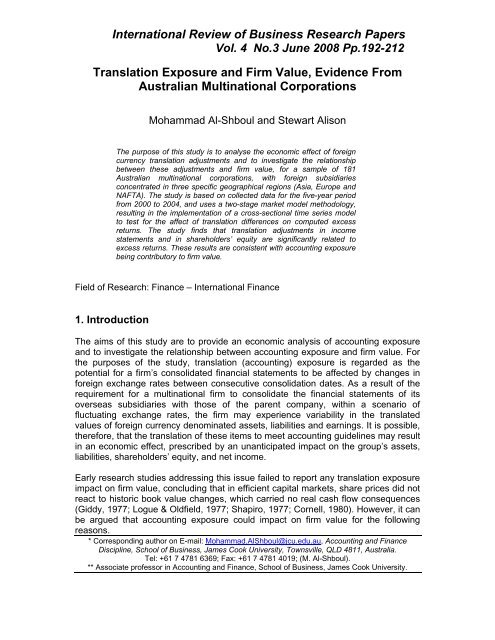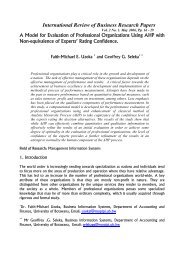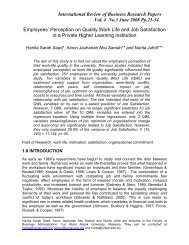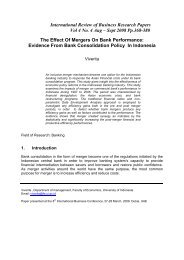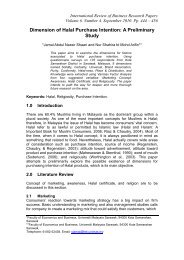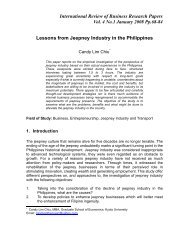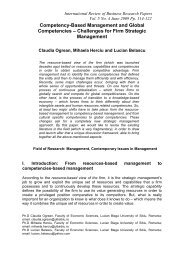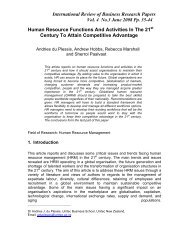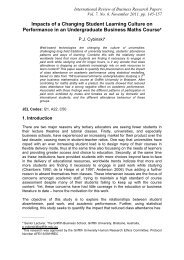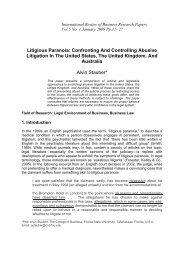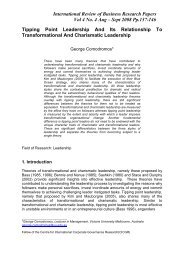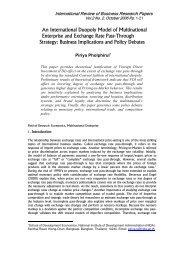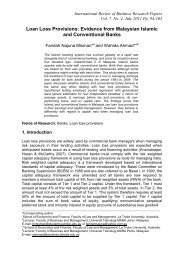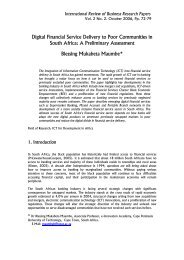Translation Exposure and Firm Value, Evidence From Australian ...
Translation Exposure and Firm Value, Evidence From Australian ...
Translation Exposure and Firm Value, Evidence From Australian ...
You also want an ePaper? Increase the reach of your titles
YUMPU automatically turns print PDFs into web optimized ePapers that Google loves.
Al-Shboul & Alison 193Firstly, the inclusion of accounting translation differences on a firm’s consolidatedincome statement <strong>and</strong> balance sheet may generate indirect cash flows, as a result oftaxation implications (Martin et al, 1998). Secondly, investors may use theconsolidated financial statements to predict the firm’s sales revenue, investmentgrowth opportunities <strong>and</strong> earnings. To the extent that these predictions are affectedby the firm’s translation exposure, it can be argued that this exposure also has thepotential to affect the firm’s share price. Finally, if potential investors use the level ofthe firm’s earnings to predict future dividend levels, then fluctuations in exchangerates, <strong>and</strong> their impact on the level of reported earnings, have the potential to impactthose predicted dividend payout ratios, <strong>and</strong> firm values (Asquith et al., 1983; Nance,Smith <strong>and</strong> Smithson, 1993). For these reasons, therefore, measuring the effect ofaccounting exposure on firm value remains an area of interest to both researchers<strong>and</strong> investors.The more recent research studies have produced somewhat mixed results. Most ofthe studies have, again, failed to provide any evidence of foreign currency translationadjustments being relevant to firm value (e.g., Callaghan & Bazaz, 1992; Soo & Soo,1994; Paurciau & Schaefer, 1995; Bartov & Bondar, 1995; Bartov, 1997; Dhaliwal etal., 1999). However, several studies have argued for such relevance (Hines, 1996;Godfrey & Yee, 1996; Martin et al., 1999; Louis, 2003; Pinto, 2005). The vast majorityof these studies have focused on investigating the U.S. market, <strong>and</strong>, to the currentauthors’ knowledge, research studies into the influence of translation exposure onthe value of <strong>Australian</strong> firms are limited in number. Godfrey (1992, 1994) examined,respectively, the importance of reporting the effects of <strong>Australian</strong> firms’ voluntaryforeign currency accounting policies on the value of the firms’ net assets, <strong>and</strong>managerial motivation for selecting among alternative, unregulated, <strong>Australian</strong>foreign currency translation methods. Godfrey <strong>and</strong> Yee (1996) examined the impactof the prescribed foreign currency translation adjustments of <strong>Australian</strong> St<strong>and</strong>ardsReview Board (ASRB) Statement No. 1012, Foreign Currency <strong>Translation</strong>, on thecurrency risk management practices of <strong>Australian</strong> mining firms. The reportingrequirements contained in ASRB 1012 had the effect of increasing the accountingexposure of firms to changes in exchange rates. The study found that <strong>Australian</strong>mining firms decreased the level of long-term foreign debt <strong>and</strong> increased the level ofequity capital in their capital structures, to mitigate the effects of the st<strong>and</strong>ard on theircontracts. These results suggested that management regarded increased translationexposure as having the potential to affect the market values of the relevant firms.The main contribution of the current study is the information it provides on therelationship between translation exposure <strong>and</strong> the market value of <strong>Australian</strong>multinational corporations, for the period January 2000 to December 2004. Followingthe methodology of Martin et al. (1998), the study examines the value relevance ofaccounting exposure through two examples of its measurement: the translatedshareholders’ equity <strong>and</strong> the translated operating earnings, from three geographicalregions [Asia-Pacific, Europe, <strong>and</strong> the North Atlantic Free Trade AssociationNAFTA)]. The inclusion of the translated operating earnings from those three regionsreflects the extensive engagement of <strong>Australian</strong> firms there, via foreign operations<strong>and</strong> subsidiary companies.The empirical results of the study reveal that, over the sample period, the cumulativeabnormal returns of the sample firms are positively associated with the incremental193
Al-Shboul & Alison 194(decremental) translated foreign operating earnings, as the <strong>Australian</strong> dollar weakens(strengthens). Further, the cumulated abnormal returns of the sample firms arepositively related to the translated gains or losses on assets or liabilities chargedagainst shareholders’ equity. These findings are consistent with translation exposurebeing a relevant factor in explaining firm value. The remainder of this paper isstructured as follows. Section 2 contains a review of the related research literature.Section 3 discusses the data <strong>and</strong> the research methodology used in the study. Theresults of the data analysis are reported in Section 4, while the conclusions aredrawn in Section 5.2. Overview of the Accounting <strong>and</strong> Economic Effects of ForeignCurrency Changes2.1 The Accounting Effect of Foreign Currency VariabilityAfter the collapse of the fixed foreign exchange-rate regime in early 1970s 1 , thedesirability of harmonising the accounting reporting systems for the consolidatedfinancial statements of multinational firms took on a new impetus. This was becauseof the potential for fluctuations in foreign exchange rates to affect the reported valuesof foreign assets, foreign liabilities, <strong>and</strong> foreign earnings when translated to theparent company’s currency. In the course of the harmonisation process, st<strong>and</strong>ardsetters have been occupied with two major questions: (1) which translation methodshould be used, <strong>and</strong> (2) how should any resulting translation differences be reported.In the years prior to 1975, four foreign currency translation methods had traditionallybeen used: the temporal method, the current rate method, the current-noncurrent 2method <strong>and</strong> the monetary-nonmonetary 3 method. In October 1975, the U.S. FinancialAccounting St<strong>and</strong>ards Broad (FASB) issued Statement of Financial AccountingSt<strong>and</strong>ards (SFAS) No. 8, Accounting for the <strong>Translation</strong> of Foreign CurrencyTransactions <strong>and</strong> Foreign Currency Financial Statement, which became effective on1 January 1976. SFAS No. 8 essentially prescribed the temporal translation method,under which all monetary items, <strong>and</strong> any other items carried at current value, aretranslated at the current (i.e., consolidation date) exchange rate. All items carried athistorical costs are translated at the relevant historical exchange rates.Most income statement items are translated at the average exchange rate for thereporting period. However items such as the amortisation of intangibles <strong>and</strong> thedepreciation of non-current assets, which can be specifically related to items carriedat historical cost, are translated at the relevant historic exchange rates. SFAS No. 8required that any resultant translation differences be reported as a component of netincome. As a result, reported earnings could fluctuate considerably, due solely tofluctuations in currency exchange rates which were outside the control of the firm.This controversial feature of SFAS No. 8 was unpopular with corporate executives,<strong>and</strong> the Statement failed to gain widespread acceptance by multinationalcorporations <strong>and</strong> the accounting profession. As a result of the unpopularity of SFASNo. 8, the Financial Accounting St<strong>and</strong>ards Board, in consultation with internationalbodies, reviewed the situation <strong>and</strong>, in December 1981, promulgated a replacementStatement, SFAS No. 52, to be effective for accounting periods beginning on or after15 December 1982. The objectives of SFAS No. 52 were twofold: (1) to provideinformation which is generally compatible with the expected economic effects of anexchange rate change on the organisation’s cash flows <strong>and</strong> equity, <strong>and</strong> (2) to194
Al-Shboul & Alison 197group reporting currency, the affiliate’s value to the entity as a whole may well rise,due to the increased competitiveness brought about by the exchange rate changeinduced reduction in production costs (Condon et al., 1990). However, assuming thatthe foreign affiliate has a positive book net assets balance, <strong>and</strong> that its local currencyis regarded as its functional currency, an accounting translation loss will result on theconsolidation of its financial statements under the current rate method. Two importantcaveats to the above ‘conflicting signals’ reasoning must be stated. Firstly, theambiguous signal generated by the consolidated annual report in this situation, willonly exist, if the foreign affiliate is treated as a self-sustaining entity, <strong>and</strong> its localcurrency regarded as its functional currency. 8 Secondly, there is an implicitassumption that relative purchasing power parity does not hold over the reportingperiod, <strong>and</strong> the effect of the depreciation of the affiliate’s functional currency is notoffset by relatively higher inflation in the country in which the affiliate is based. Theweight of empirical evidence, however, suggests that purchasing power parity is, atbest, a long-term relationship, <strong>and</strong> does not have much validity in the short ormedium terms (e.g. Kravis & Lipsey, 1978; Adler & Lehman, 1983; Rogoff, 1996).The case of ‘self-sustaining’ foreign affiliates, which buy, sell, borrow <strong>and</strong> repay intheir respective domestic currencies is an interesting one. A depreciation in the valueof a local currency is likely to lead to an increased competitiveness for the relevantforeign affiliate, leading, in turn, to increased profit margins <strong>and</strong> economic value. Onthe other h<strong>and</strong>, when an appreciation of the local currency occurs, selling output inan open market will be harder, because the goods of foreign competitors becomerelatively cheaper (Aggarwal et al. 1981). Thus, to maintain their competitiveness inthis situation, foreign affiliates may have to reduce their sales prices. Since the costsof labour are relatively ‘sticky’ (Gallardo et al., 2000), it is unlikely that they can bereduced by the same measure as selling prices, resulting in decreased profit margins<strong>and</strong> reduced economic value for the affiliate. Again, assuming that the foreign affiliatehas a positive book net assets balance, <strong>and</strong> that its local currency is regarded as itsfunctional currency, an accounting translation ‘gain’ will result on the consolidation ofits financial statements. Thus, in a globally competitive marketplace, where thedem<strong>and</strong> <strong>and</strong> supply mechanism determines the real output prices, but, because ofbarriers to the free movement of labour, local markets determine real labour costs,firms with foreign subsidiaries based in countries with soft currencies, are better off,no matter where they sells their goods (Louis, 2003).The intention of accounting st<strong>and</strong>ards is to devise accounting practices that willproduce <strong>and</strong> disclose translation adjustments which reflect the impact of exchangerate movements on the group reporting currency value of foreign affiliates (O’Brien,1997). But, since translation exposure to these exchange rate movements canfrequently differ from the corresponding economic exposure, conflicting signals of theresulting changes in the values of foreign affiliates are generated, depending onwhether the user takes an accounting or an economic perspective. Whethertranslation differences are reflected in the values of multinational firms is an empiricalquestion which the current study attempts to address.197
Al-Shboul & Alison 1983. Related LiteratureAn early study by Dufey (1972) discussed how the depreciation of a foreign currencyagainst a group’s reporting currency could generate the confrontational situationdiscussed in Section 2 of the present study. Because of accounting translationpractices, the depreciation of the reporting currency of a foreign affiliate may reducethe amount of reported earnings of that affiliate which are included in theconsolidated results of the group. But, the currency depreciation may actuallyimprove the economic competitiveness, <strong>and</strong> ultimate financial profitability of theaffiliate. Because of the conspicuousness of translation adjustments in consolidatedearnings statements, Dufey comments on how potentially profitable direct investmentopportunities, in countries with unstable currency histories, might well be foregone.Another early study by Aggarwal et al. (1978) examined the effect of FASB No. 8 onreported financial statements of U.S. based multinational firms. Aggarwal concludedthat the ‘procrustean’ accounting adjustments required by FASB No. 8 were not likelyto reflect the economic reality of the underlying changes in exchange rates.Therefore, reported accounting figures were likely to misrepresent the economicreality of the firm’s exposure to exchange rate risk, unless they were supplementedwith other detailed information. This view was supported by O’Brien (1997) whoasserted that accounting methods might either underestimate or overestimate thetrue economic exposure, in terms of changes in some microeconomic factors. Thesefactors include such things as the elasticity of exchange rate changes or theresponsiveness of firm level operating profits to changes in exchange rate.In a similar vein, Garlicki et al. (1987) argued, in support of FASB No. 52, that, sincea firm’s accounting exposure is not necessarily aligned with its economic exposure,reported translation gains or losses are merely ‘cosmetic changes,’ <strong>and</strong> notnecessary related to changes in the future cash-flows of the firm. Thus, eliminatingthese gains or losses may lead to higher quality earnings. However, although SFASNo. 52 may have placated irritated executives of multinational firms, some academicresearchers have been critical of the propriety of reporting foreign currencytranslation gains of losses in shareholders’ equity. For example, Beaver <strong>and</strong> Wolfson(1984) illustrate that accounting translation gains <strong>and</strong> losses capture, at least, someof the economic factors behind the interplay of interest rates <strong>and</strong> exchange rates,<strong>and</strong>, therefore, to exclude those factors from earnings can result in misleadingearnings-based performance evaluations of the foreign operations of multinationalfirms. Beaver <strong>and</strong> Wolfson also criticise SFAS No. 52 regarding its requirement thatitems recorded at historical cost in the balance sheets of foreign subsidiaries must betranslated at current exchange rates. The authors conclude that this practiceproduces accounting numbers which are not interpretable <strong>and</strong> serves to compoundthe bias produced by SFAS No. 8 in the translation of long-term monetary items.As regards the empirical research evidence on the relationship between reportedforeign currency translation adjustments <strong>and</strong> firm value, two distinct groupings haveemerged. The first group of empirical studies either to report significant evidence ofa relationship between foreign currency translation adjustments <strong>and</strong> firm value, oronly partial evidence of such a relationship. In a study seeking to further explore thefindings of an earlier study (Bartov <strong>and</strong> Bondar, 1994), Bartov <strong>and</strong> Bondar (1995)investigate the possibility that the change in reporting requirements from SFAS No. 8198
Al-Shboul & Alison 199to SFAS No. 52 enhance the market’s ability to assess the impact of movements inexchange rates on firm values. As in the case of their 1994 study, Bartov <strong>and</strong> Bondar(1995) found no evidence of a contemporaneous relationship between exchange ratemovements <strong>and</strong> firm value. However, after controlling for firm size, the study didproduce evidence that, in the case of those firms choosing the foreign currency asthe functional currency of their overseas subsidiaries, the change in reporting regimeresulted in the disappearance of a lagged response of firm value to movement inexchange rates. With specific regard to those firms choosing the foreign currency asthe functional currency, the authors interpreted their results as evidence of thetranslation reporting requirements of FASB No. 52 facilitating prediction by investorsof the impact of changes in exchange rates on the market value of U.S. firms withforeign operations.For a sample of 97 U.S. multinational firms which voluntarily adopted SFAS No. 52 in1981, Pourciau <strong>and</strong> Schaefer (1995) examined the market response to the firms’reported earnings. Those firms which ‘switched early’ to SFAS No. 52 from theprevious reporting regime specified by SFAS No. 8, almost invariably reported anincrease in earnings. Using a cross-sectional abnormal returns model, the authorsfound no evidence that the sample firms’ income-increasing change in reportingpractice, incremental to unexpected earnings from other sources, had a significanteffect on their market values. The authors interpreted these results as beingconsistent with the efficient market hypothesis, whereby security prices will only reactto earnings disclosures if these contain information relevant to unexpected changesin the amount <strong>and</strong> risk of future cash flows of the firm.Using data from a sample of U.S. multinational firms, Bartov (1997) investigated thevalue relevance of translation adjustments related to alternative translation methods.Bartov’s results indicated that the introduction of SFAS No. 52 resulted in significantenhancement in the valuation relevance of the accounting numbers associated withthe restatement of a foreign operation’s financial statements. However, thissignificant enhancement applies only to that group of firms, whose subsidiaries useda foreign currency as a functional currency. For those firms which chose the U.S.dollar as the functional currency for their subsidiaries, no significant association wasfound between currency translation adjustments <strong>and</strong> changes in stock price. Bartov’sresults, regarding the value enhancement being restricted to those firms choosingforeign currencies as the functional currencies, corroborate the findings of earlierstudies by Griffin <strong>and</strong> Castanias (1987) <strong>and</strong> Collins <strong>and</strong> Salatka (1993).Following Dechow (1994), Dhaliwal et al. (1999) employed the return to earningsassociation approach to examine whether the summary measure of firmperformance, the Statement of Income <strong>and</strong> Comprehensive Income, required underSFAS No. 130 to be included in a firm’s primary financial statements, is morestrongly associated with returns/market value, or better predicts future cashflows/income than the net income alone. As noted previously, one of the threecomponent adjustments of comprehensive income is the change in the cumulativeforeign currency translation adjustments 9 . The study found no evidence thatcomprehensive income is more strongly associated with returns/market value or is abetter predictor of future cash-flows/income than net income. The only component ofcomprehensive income found to improve the association between income <strong>and</strong>returns, was the marketable securities adjustment. These results suggest that, as an199
Al-Shboul & Alison 200element of comprehensive income, foreign currency translation adjustments are notvalue relevant. This conclusion is consistent with Dee (1999).The second empirical studies group does provide evidence of a relationship betweentranslation adjustments <strong>and</strong> firm value. Using an amended version of an early modeldeveloped by Litzenberger <strong>and</strong> Rao (1971), which views the market value of a firmas a capitalisation of earnings, adjusted for both systematic risk <strong>and</strong> growth,Callaghan & Bazaz (1992) tested the hypothesis of whether equity translationadjustments, such as those prescribed in SFAS No. 52, are considered by investorsas a component of consolidated income. Although Callaghan <strong>and</strong> Bazaz’s study wasnot designed as a test of the value relevance of translation adjustments, per se, theirresults are relevant to the current study since they found evidence, via thecapitalisation of reported earnings, consistent with the hypothesis that equitytranslation adjustments are viewed by investors as a component of income.Soo <strong>and</strong> Soo (1994) used an abnormal returns model to examine the effect ofaccounting exposure on firm value for a sample of 235 multinational U.S. firms, fortwo seven-year sample periods: 1976 – 1982 <strong>and</strong> 1981 – 1987. This design allowedthe authors to test whether any market valuation of foreign exchange gains <strong>and</strong>losses was different between the periods covered by SFAS No. 8 <strong>and</strong> SFAS No. 52.It also allowed for the testing of whether any market reaction to translationadjustments differed from the reaction to transaction adjustments or other earnings.Those firms which exclusively chose the U.S. dollar as the functional currency of theirforeign affiliates were excluded from the sample. The results of the study wereconsistent with the market valuing foreign exchange adjustments reported in income,under both accounting st<strong>and</strong>ards. In addition, the results indicated market valuationof the translation adjustments reported under stockholders’ equity under SFAS No.52. However, the sensitivity of firm value to the adjustments reported in stockholders’equity was smaller than the sensitivity to other earnings. This result led the authors tosuggest that translation adjustments should be reported separately from otherearnings <strong>and</strong> from transaction gains <strong>and</strong> losses.Martin et al. (1998) tested the hypotheses of whether the translated shareholders’equity <strong>and</strong> the translated earnings figures affected the excess return of the firm.Using a sample of 168 U.S. multinational firms (1,071 sample observations) withforeign operations primarily based in Europe, for the period 1987 – 1993, the authorsregressed the monthly stock returns of each individual firm on the returns of both theEuropean <strong>and</strong> the U.S. stock markets. The saved coefficients from this regressionwere then used to calculate the monthly abnormal return for each firm, which, in turnformed the dependent variable in a cross-sectional time series regression, with theindependent variables including the translated shareholders’ equity <strong>and</strong> thetranslated earnings. The results showed evidence of a significant relationshipbetween the values of the firms in the sample, as quantified by excess returns, <strong>and</strong>:(1) overall operating earnings, (2) translation effect on earnings, (3) translation effecton shareholders’ equity. On the basis of these results the authors concluded thataccounting exposure had a significant impact on firm value.Using a sample of U.S. multinational manufacturing companies, Louis (2003)examines the relation between the foreign currency translation adjustments <strong>and</strong> firmvalue. The relevant study period is 1985 – 2001, with 4,972 sample observations. A200
Al-Shboul & Alison 201four-factor regression model is implemented to examine the impact of foreigntranslation adjustment <strong>and</strong> net income on the firm’s actual stock returns. The authorincludes two control variables in his model: transaction gain/loss <strong>and</strong> foreign incometax. Based on a prior economic analysis, Louis hypothesised that positive foreigntranslation adjustments of the manufacturing firms in his sample would be associatedwith decreases in firm value. The results of the study were consistent with thishypothesis, prompting the author to voice concerns about an ‘accounting incomecomputation that recognizes a positive translation adjustment as an increase invalue 10 .’Indirect evidence of the value relevance of translation adjustments is provided by theliterature investigating the efficacy of hedging foreign exchange exposure. In asurvey of 160 Swedish firms over the period 1997 – 2001, designed to provideempirical evidence of the determinants of firm’s hedging decisions, Hagelin (2003)found no evidence indicating that translation hedges were used to increase firmvalue. This suggests that, unlike the situation with transaction exposure, hedgingtranslation exposure is likely to be unacceptable to shareholders, unless managersspecifically justify the use of this type of hedging. This suggestion appeared to havesome validity, as Hagelin <strong>and</strong> Pramborg (2005) found evidence supporting a positiverelationship between hedging translation exposure <strong>and</strong> the existence of loancovenants, In another study, Hagelin <strong>and</strong> Pramborg (2004) found that the Swedishfirms in their sample reduced both transaction <strong>and</strong> translation exposure by the use offinancial hedges.Contending that accounting translation differences are only value relevant to firms ifthey measure economic exposure to exchange rate movements, Pinto (2005) testsfor value relevance using a sample of 109 U.S. multinational firms, with subsidiariesin Mexico <strong>and</strong> Germany, for the period 1991 to 1996. Rather than using a returnsmodel which investigates a hypothesised reaction of security prices to accountinginformation, <strong>and</strong>, therefore, incorporates translation differences at face value, Pintouses a ‘levels’ model which searches instead for a correlation between the marketprices of securities <strong>and</strong> accounting variables. Pinto follows Ohlson’s (1995)procedure by running a regression between the market value (dependent variable) ofequity <strong>and</strong> both the book value of equity <strong>and</strong> accounting earnings per share(explanatory variables). Consistent with a suggestion by Lev (1989) that valuationmodels may be better specified when earnings are decomposed, Pinto addsadditional ‘interaction terms’ to his model which serve as proxies for the theoreticalsources of economic exchange rate exposure. These include asset composition,location of foreign investment, <strong>and</strong> the timing of exchange rate shocks. The mainfinding of Pinto’s study is that foreign currency translation adjustments aresignificantly value relevant when parameter estimates are allowed to vary in crosssection.A major implication is that the results of previous studies, which incorporatedtranslation adjustments at face value, should be treated with caution, as theirmethodologies may have resulted in a masking of the actual sources of exchangerate exposure. The conflicting results of previous studies have prompted us toinvestigate the question of the value relevance of translation adjustments in an<strong>Australian</strong> context. To our knowledge, no empirical work using data for <strong>Australian</strong>multinational firms, has been published to date201
4. Data <strong>and</strong> Methodology4.1 DataAl-Shboul & Alison 202Several public sources were accessed to collect the data for the study. Initially, the500 largest firms listed on the <strong>Australian</strong> Stock Exchange (ASX) were identified foreach fiscal year (the financial year ending on 30 June) for the period, 2000 to 2004.After eliminating delisted <strong>and</strong> newly listed firms, it was found that 485 firms remainlisted over the total period. Those firms were subsequently restricted by theapplication of specific criteria to select our study sample. Firstly, financial firms wereexcluded. Because the core businesses of these firms were purely concentrated onfinancial services, it was assumed that they were prepared to undertakecomprehensive strategies to hedge all their exposure positions. The elimination offinancial firms reduced the number of eligible firms to 379. Secondly, since the aim ofour study is to examine the relationship between accounting exposure <strong>and</strong> the valueof <strong>Australian</strong> multinational firms, only corporations heavily engaged with foreignoperations through foreign subsidiaries are included. Therefore, those firms havingno foreign subsidiaries over the study period were excluded from the sample. Aftermanually surveying the geographical segment reports contained in the notes to thefinancial statements in the annual report of each firm 11 , 181 such firms wereidentified, with a total number of 2,489 foreign subsidiaries located in foreigncountries <strong>and</strong> geographical regions.Our survey of these subsidiaries, for the 2004 fiscal year, indicated that the vastmajority of the foreign subsidiaries of the 181 sample firms were heavily dispersedacross the following three geographical regions, ranked respectively: Asia-Pacificregion (including the Asia Crisis region) (997 subsidiaries); European Region (734subsidiaries); NAFTA Region (487 subsidiaries) 12 . The numbers of subsidiaries soidentified is consistent with the findings of a survey conducted by the <strong>Australian</strong>Bureau of Statistics (ABS, 2004), which reported that the vast majority of <strong>Australian</strong>foreign subsidiaries in 2002/2003 was spread across the three geographical regions:Asia-Pacific (1,586 subsidiaries); Americas (1,111 subsidiaries); Europe (940subsidiaries). Another indication of the direction of the foreign involvement of<strong>Australian</strong> firms, with which our sample data is consistent, is Harcourt (2007).Harcourt reported that the numbers of firms in 2005, with countries in the Asia-Pacificregion as specific export destinations, were, respectively: 17,394 firms (NewZeal<strong>and</strong>), 6,397 firms (Singapore), 4,984 firms (Hong Kong). The number of firmsexporting to the U.S. was 9,253 <strong>and</strong> to the U.K., 5,486. These findings provideconfirmation that the vast majority of <strong>Australian</strong> foreign operations are concentratedin the three geographical regions identified in our study. The present study, therefore,examines the effects of accounting exposure on the value a sample of 181 firmsdescribed above, for the period from January 2000 to December 2004.4.2 MethodologyTo examine the relationship between the translated foreign currency gains or losses<strong>and</strong> firm value, we use a two-pass market model. Consistent with the assumptionthat market residuals are a function of earnings (Lev, 1989), Martin et al. (1998)incorporated the effect of changes in earnings <strong>and</strong> shareholders’ equity, resultingfrom accounting translation differences in their model. To detect this effect, they202
Al-Shboul & Alison 203firstly used a two-factor linear regression model, to estimate residual returns as proxyof firm values, by regressing individual firms’ on the returns of both the European <strong>and</strong>U.S. markets for 168 U.S.-based multinational firms, heavily engaged in foreignoperations in Europe, over the period 1987 – 1993. Following the methodology ofMartin et al. (1998), the present study was designed to detect the impact oftranslated gains <strong>and</strong> losses on the values of the 181 <strong>Australian</strong> multinational firms inour sample, for the period, 2000 to 2004, with specific reference to the threegeographical regions previously identified. In the first pass, a four-factor ordinaryleast squares linear regression model was used to estimate the abnormal returns.The model regresses the individual stock returns of the sample firms on the stockmarket returns of the three regions plus the return on the <strong>Australian</strong> stock market,<strong>and</strong> is of the formSR it = δ 0i + δ 1i R Mt,ASIA + δ 2i R Mt,EURO + δ 3i R Mt,NAF + δ 4i R Mt,AUS + ε it (1)In Equation (1), SR it , is the monthly stock return for firm i, at month t. All data relatingto each firm’s stock prices for the sample period were obtained from databasecompiled by the <strong>Australian</strong> Graduate School of Management (AGSM). R Mt,ASIA , refersto the monthly return on the Asian market index, at month t, proxied by the 225NIKKEI Index (N225). R Mt,EURO , is the European market index return at month t,proxied by the UK FTSE Index (FTSE 100). R Mt,NAF , is the return on the NAFTAmarket index, at month t, proxied by the U.S. market index (GSPC S&P 500 index).R Mt,AUS , is the monthly <strong>Australian</strong> market return, at month t. The proxy for this returnis the All Ordinary Index (AOI) accessed from the database of the <strong>Australian</strong>Graduate School of Management (AGSM). All these indices are computed on atrade-weighted basis <strong>and</strong> all the monthly returns are calculated in continuouslycompounded form, over the entire period. The residual terms, ε it , from Equation (1)were saved, <strong>and</strong> form the abnormal returns used in the second-pass regression asnow described. It was assumed that no collinearity or multicollinearity existed amongthe explanatory variables. Once the parameters Equation (1) were estimated, themonthly residual returns were computed by subtracting the estimated returns fromthe actual returns for each firm, for each month. This process can be expressed asfollows:ANR it = ε it = SR it – (δ 0i + δ 1i R Mt,ASIA + δ 2i R Mt,EURO + δ 3i R Mt,NAF + δ 4i R Mt,AUS ) (2)Where: ANR it , is the monthly abnormal returns for firm i, at month t, over the 2000 -2004 estimation period. The other variables in equation (2) are estimated in equation(1). The monthly abnormal returns for each firm were then accumulated for eachcalendar year in the sample period, to form the variable, CANR it , used in the secondpassregression. In the second-pass model we use a cross-sectional time seriesmodel to test the impact of the translated operating earnings, <strong>and</strong> the translatedshareholders’ equity, on these residual returns. For each firm, for each year, thecumulated abnormal returns are regressed on its scaled translated operatingearnings from the three geographical regions, its scaled translated total operatingearnings, <strong>and</strong> the scaled value of the total annual translated gains or losses onassets <strong>and</strong> liabilities charged against its shareholders’ equity. Our study, therefore,extends Martin et al.’s model by including extra variables, which are considered asproxies for the effects of the translated operating earnings from the three203
Al-Shboul & Alison 204geographical regions identified earlier. The model designed to estimate the impact ofaccounting exposure on firm value, is expressed as follows:CANR it = β 0 + β 1 EASIA it + β 2 EEUR it + β 3 ENAF it + β 4 TOE it + β 5 TEQTY it + η it (3)Over the period 2000-2004: CANR it , is the cumulated monthly abnormal returns offirm i for year t (total observations: 905); EASIA it , is the total annual Asian translatedoperating earnings for firm i, divided by its total translated operating earnings, foryear t.; EEUR it , is the total annual European translated operating earnings for firm i,divided by its total operating earnings, for year t.; ENAF it , is the total annual NAFTAtranslated operating earnings for firm i, divided by its total operating earnings for yeart.; <strong>and</strong> TOE it , is the total annual operating earnings for firm i, divided by its total salesfor year t. All the operating earnings variables were collected from the geographicalprofit segment report in the annual report of each firm. TEQTY it , is the total annualtranslated profit (loss) on assets <strong>and</strong> liabilities charged against shareholders’ equityfor firm i, scaled by its total shareholders’ equity, for year t. These translated profits orlosses are sourced from the translated foreign currency gains or losses itemsincluded in the reserves section in the balance sheet of each firm; β 0 – β 5 , are therelevant regression coefficients <strong>and</strong> η it , is the error term. An OLS estimation methodwas used with adjustments for potential econometric problems, such as collinearity ormulticollinearity, <strong>and</strong> heteroskedasticity. In Equation (3), a significant, β 4 , coefficientwould indicate that excess monthly returns are associated with changes in the annualtotal operating earnings. Similarly, significant, β 1 – β 3 , coefficients would indicate avalue-influencing role for the translation effects in earnings from the Asia-Pacific,European, <strong>and</strong> NAFTA regions, while a significant β 5 coefficient would be consistentwith a similar role for the translation effects in shareholders’ equity.5. Empirical ResultsIn the first instance, a univariate analysis was implemented, using both summarystatistics <strong>and</strong> a Pearson correlation coefficients matrix, for the variables contained inthe models described above. Summary statistics for all the variables used inEquation (3) are reported in Table 1.Table 1Summary Statistics for All the Variables Used in the Cross-Sectional RegressionModel which Assesses the Effects of Accounting <strong>Exposure</strong> on Residual Returnsover the Period, 2000 to 2004EASIA ENAF EEUR TOE TEQTY CANR *Observations 905 905 905 905 905 905Mean 0.053 0.031 0.821 0.707 -0.006 -0.001First Quartile 0.000 0.000 0.000 0.299 -0.002 -0.183Median 0.000 0.000 0.000 0.952 0.000 -0.007Third Quartile 0.012 0.000 0.044 0.989 0.003 0.177St<strong>and</strong>ard Deviation 0.247 0.138 0.166 0.391 0.079 0.397Minimum -0.666 -0.695 -0.562 -0.989 -0.745 -1.960Maximum 0.560 0.593 0.666 0.998 0.689 1.711* CANR is the cumulated monthly residual return for firm i for each calendar year, from January2000 to December 2004. The monthly residual returns are estimated using trade-weighted marketindices.204
Al-Shboul & Alison 205In addition, a Pearson correlation coefficients matrix was compiled to determine thedegree of correlation between all the relevant variables, <strong>and</strong> to identify anycollinearity or multicollinearity problems, which might exist between the explanatoryvariables of the model specified in Equation 3. This matrix is shown in Table 2.Table 2Pearson Correlation Coefficients Matrix of All the Variables Used in the Cross-Sectional Regression ModelEASIA ENAF EEUR TOE TEQTY CANREASIA 1ENAF-0.010 1t-statistic (-0.289)EEUR 0.184*** -0.0081(5.626) (-0.242)TOE -0.014 -0.003 0.009 1(-0.406) (-0.089) (0.278)TEQTY -0.004 -0.002 -0.002 0.033 1(-0.124) (-0.054) (-0.065) (0.985)CANR 0.042 0.050 0.118*** 0.041 0.061*1(1.257) (1.510) (3.562) (1.223) (1.824)The number of observations (firms) is 181. Notes: (i) the levels of significance (1%, 5%, 10%) are:***, **, *, respectively; (ii) A two-tailed t-test statistic is used to test the significance of the correlationcoefficients (r). This test is computed as follows: t= (r n−2 )/( 1−r2) , where n is the number ofobservations: 905.Among the independent variables, the only significant correlation is between thetranslated operating earnings from the Asia-Pacific region with those from theEuropean region. The pairwise correlation coefficient is 0.184, which is significant atthe 1% level (two-tailed test). This significant correlation coefficient indicates thatcollinearity between those two variables is highly likely to occur. Thus, includingthese variables in the same model is likely to create a biased estimation of theparameters of model. It was decided that, to eliminate this problem <strong>and</strong> obtain theBest Linear Unbiased Estimators, the only feasible policies were to omit one of thetwo highly correlated variables from the model <strong>and</strong> to create alternative modelspecifications. A subsequent multivariate analysis of the resulting models foundevidence of heteroskedasticity in each case. White’s (1980) model was implementedto adjust for the heteroskedasticity problem. The results of the multivariate analysisare summarised in Table 3. The results indicate that the direction of the relationshipbetween accounting exposure <strong>and</strong> cumulated abnormal returns is consistent with theresults indicated in the univariate analysis (Table 2).Table 3The Coefficients Of The Estimated Cross-Sectional Regression Model WhichAssesses The Effect Of Accounting <strong>Exposure</strong> On The 12-Month CumulatedAbnormal Returns Over The Period <strong>From</strong> 2000 To 2004Model ModelModel 3a Model 3b Model 3cModel 3f3d 3eInterceptt-statistic-0.033*(-1.880)-0.025(-1.405)-0.022(-1.271)-0.030*(-1.721)-0.026(-1.477)-0.032*(-1.792)205
Al-Shboul & Alison 206EASIA0.035 0.068*0.069*(0.938) (1.944)(1.970)ENAF0.001***0.001***0.001*** 0.001***(3.483)(3.418)3.423 3.483EEUR0.328***0.338***0.339***(2.792)(2.984)(2.995)TEARNS0.024* 0.024* 0.024* 0.023* 0.024* 0.023*(1.812) (1.858) (1.855) (1.803) (1.862) (1.807)TEQTY0.078* 0.077* 0.077* 0.077* 0.077* 0.078*(1.711) (1.732) (1.741) (1.712) (1.733) (1.713)Observations 905 905 905 905 905 905Adjusted R 2 4% 3% 4% 3% 3% 4%F-statisticsp-value4.0550.0012.1120.0975.8080.0012.3260.0732.1670.0714.9630.001Notes: (i) t-statistic is used with the levels of significance (1%, 5%, 10%) are: ***, **, *, respectively;(ii) CANR it = β 0 + β 1 EASIA it + β 2 EEUR it + β 3 ENAF it + β 4 TOF it + β 5 TEQTY it + η it ; where: CANR it , isthe average of the cumulated monthly abnormal returns, over each calendar year for the estimationperiod 2000 – 2004, for each firm i; EASIA it , the annual Asian translated operating earningsdivided by the total operating earnings for firm i over 2000-2004; EEUR it , the annual Europeantranslated operating earnings divided by the total operating earnings for firm i; ENAF it , the annualNAFTA translated operating earnings divided by the total operating earnings for firm i; TOE it , is theannual total operating earnings divided by total sales for firm i. TEQTY it , is the total annualtranslated profit (loss) on assets <strong>and</strong> liabilities against shareholders’ equity scaled to the totalshareholders’ equity for firm i; β 0 – β 5 , are the regression coefficients; η it , is the error term. All theobservations of the independent variables are collected over each financial year for the period 2000– 2004 (905 observations). An OLS is used to estimate the parameters of the model with White’s(1980) model to adjust for heteroskedasticity.The results in Table 3 clearly indicate that all the variables used in models (3a – 3f)are found to be significantly positively associated with cumulative abnormal returns.This suggests that the variables, annual translated operating earnings, annualtranslated operating earnings from each region, <strong>and</strong> the translated gain or losscharged annually against shareholders’ equity, which serve as proxies for translationexposure, are all viewed by the market as value additive. Positive translationadjustments are associated with increases in market value. This result is consistentwith the findings of Martin et al. (1998), but at variance with the findings of severalother studies (e.g. Callaghan & Bazaz, 1992; Soo & Soo, 1994; Pourciau & Schaefer,1995; Bartov, 1997; Dhaliwal et al., 1999).The full model 3(a) provides estimates of the relevant coefficients, without taking intoaccount the collinearity problem between the translated earnings from Asia <strong>and</strong>Europe. It was found that, total translated operating earnings, translated operatingearnings from three regions, <strong>and</strong> gains or losses on assets <strong>and</strong> liabilities charged toshareholders’ equity are all related to accounting exposure. These relationships areall significant with the exception of the relationship between accounting exposure <strong>and</strong>the translated operating earnings from Asia. It was considered that this inconsistencyin the results may have been due to the collinearity problem identified earlier, <strong>and</strong>three alternative models, 3(b), 3(c) <strong>and</strong> 3(d) were implemented accordingly. Theresults indicate a significant relationship between all the relevant estimatedcoefficients of these three models, <strong>and</strong> accounting exposure. Again, to deal with thecollinearity problem, the final two alternative models to 3(a), i.e. models 3(e) <strong>and</strong> 3(f),which omit the translated operating earnings from the European <strong>and</strong> Asia-Pacific206
Al-Shboul & Alison 207regions, respectively, were implemented. When the European translated operatingearnings are omitted (model 3e), evidence is found of a significant relationshipbetween all the other variables <strong>and</strong> accounting exposure. This evidence remainsstrong when the Asia-Pacific translated operated earnings are omitted (model 3f).6. ConclusionAs noted in Section 1, the purposes of this study are to provide an economic analysisof accounting exposure <strong>and</strong> to investigate the relationship between accountingexposure <strong>and</strong> firm value. Accounting (translation) exposure is regarded as thepotential for a firm’s consolidated financial statements to be affected by changes inforeign exchange rates between consecutive consolidation dates. While the empiricalevidence is mixed, the results of some previous studies are consistent withtranslation exposure, manifested in an unanticipated impact on a multinational firm’consolidated assets, liabilities, shareholders’ equity, <strong>and</strong> net income, affecting thefuture cash flow of the firm <strong>and</strong>, hence, its market value. While the translationadjustments specified in accounting st<strong>and</strong>ards are intended to reflect the impact ofexchange rate changes on the reporting currency value of a multinational firm, themagnitude of the firm’s economic exposure may be very different from the accountingexposure underlying the translation adjustments. Nevertheless, the results of thecurrent study indicate that firm values are sensitive to adjustments which are nottransaction based, arise essentially from the need to maintain the equalityrepresented by the accounting equation, <strong>and</strong> involve no expenditure of cash, per se.It can be argued, therefore, that the results are consistent with AASB No. 1012having achieved its stated objectives of specifying methods reflective of theunderlying relationships between the entity <strong>and</strong> its foreign operations <strong>and</strong> thedisclosure of information allowing the users of financial statements to assess thesignificance to the firm of movements in exchange rates.Considered within the context of an efficient securities market, the results wouldsuggest that translation accounting adjustments, at least to some extent, reflect thefirm’s economic exposure <strong>and</strong>, therefore, have value to investors. Perhaps theeconomic value of translation adjustments lies in their ability to help predict theamount <strong>and</strong> risk of the future cash flows expected to accrue to multinational firms.For example, the translation disclosures may provide information to the market aboutthe impact of future exchange-rate changes on the income earned by foreignsubsidiaries, affecting, in turn, the cash flows ultimately available for repatriation tothe parent company, <strong>and</strong> available to pay dividends. Finally, the results of the studymay add to the debate regarding the, not uncommon, corporate policy of hedgingtranslation exposure with, for example, financial derivatives or balance sheet hedges.Such hedging activity is carried out despite the fact that it is almost impossible tohedge transaction exposure <strong>and</strong> translation exposure, simultaneously, since thereduction of one usually changes the amount of the other. Notwithst<strong>and</strong>ing, somemanagers implement the highly debatable policy of using hedging techniques, whichnecessitate cash transactions, to reduce non-cash losses.207
Al-Shboul & Alison 2087. ReferencesAdler, M., <strong>and</strong> Lehmann, B. 1983. “Deviations from Purchasing Power Parity in the LongRun”, Journal of Finance, Vol. 28, No. 5, pp. 1471-1487Aggarwal, R. 1978. “FASB No. 8 And Reported Results Of Multinational Operations: Hazardfor Managers <strong>and</strong> Investors”, Journal of Accounting, Auditing <strong>and</strong> Finance, Vol. 1, No.3, pp.197-216.Asquith, P., <strong>and</strong> D. Mullins, W. Jr. 1983. “The Impact Of Initiating Dividend Payments OnShareholders' Wealth”, Journal of Business, Vol. 56, No. 1, pp. 77-96.<strong>Australian</strong> Accounting St<strong>and</strong>ards Board (AASB). 1987. “Foreign Currency <strong>Translation</strong>”Statement of Financial Accounting St<strong>and</strong>ards No. 1012, Melbourne, September.<strong>Australian</strong> Accounting St<strong>and</strong>ards Board (AASB). 2004. “The Effects of Changes in ForeignExchange Rates”, Statement of Financial Accounting St<strong>and</strong>ards No. 121, Melbourne,July.<strong>Australian</strong> Bureau of Statistics (ABS). 2004. “<strong>Australian</strong> Outward Foreign Affiliates Trade(SOFAT): Experimental Results”, Catalogue No. 5495.0.Bartov, E., <strong>and</strong> Bodnar, G. M. 1994. “<strong>Firm</strong> Valuation, Earnings Expectations, <strong>and</strong> theExchange-Rate <strong>Exposure</strong> Effect”, Journal of Finance, Vol. 49, No. 5, pp. 1755-1785.Bartov, Eli. 1997. “Foreign Currency <strong>Exposure</strong> of Multinational <strong>Firm</strong>s: Accounting Measures<strong>and</strong> Market Valuation”, Contemporary Accounting Research, Vol. 14, No. 4, pp. 623-652.Bartov, Eli., <strong>and</strong> Bodnar, G. M.1995. “Foreign Currency <strong>Translation</strong> Reporting <strong>and</strong> theExchange-Rate <strong>Exposure</strong> Effect”, Journal of International Financial Management <strong>and</strong>Accounting, Vol. 6, No. 2, pp. 93-114.Beaver, W. H., <strong>and</strong> Wolfson, M. A. 1982. “Foreign Currency <strong>Translation</strong> <strong>and</strong> Changing Pricesin Perfect <strong>and</strong> Complete Markets”, Journal of Accounting Research, Vol. 20, No. 2, pp.528-550.Beaver, W., <strong>and</strong> Wolfson, Mark.1984. “Foreign Currency <strong>Translation</strong> Gains <strong>and</strong> Losses:What Effect Do They Have <strong>and</strong> What Do They Mean?”, Financial Analysts Journal, Vol.40, No. 2, pp. 28-37.Callaghan, J. H., <strong>and</strong> Bazaz, M. S. 1992. “Comprehensive Measurement of Foreign Income:The Case of SFAS No. 52”, International Journal of Accounting, Vol. 27, No. 1, pp. 80-87.Clarke, F. L. 1977. “A Note on Exchange Rates, Purchasing Power Parities <strong>and</strong> <strong>Translation</strong>Procedures”, Abacus, Vol. 13, No. 1, pp. 60-66.Collins, D. W., <strong>and</strong> Salatka, W.K. 1993. “Noisy Accounting Earnings Signals <strong>and</strong> EarningsResponse Coefficients: The Case of Foreign Currency Accounting”, ContemporaryAccounting Research, Vol. 10, No. 1, pp. 119-159.Condon, T., Corbo, V., <strong>and</strong> De Melo, J. 1990. “Exchange Rate Based Disinflation, WageRigidity, <strong>and</strong> Capital Inflows: Tradeoffs for Chile, 1977-1981”, Journal of DevelopmentEconomics, Vol. 32, No. 1, pp. 113-131.208
Al-Shboul & Alison 209Cornell, B. 1980. “Inflation, Relative Price Changes, <strong>and</strong> Exchange Risk”, FinancialManagement, Vol. 9, No. 3, pp. 30-34.Dechow, P. M. 1994. “Accounting Earnings And Cash Flows As Measures Of <strong>Firm</strong>Performance: The Role of Accounting Accruals”, Journal of Accounting <strong>and</strong> Economics,Vol. 18, No. 1, pp. 3-42.Dee, C. C. 1999. “Comprehensive Income <strong>and</strong> Its Relation to <strong>Firm</strong> <strong>Value</strong> <strong>and</strong> TransitoryEarnings”, Working Paper, Louisiana State University.Dhaliwal, D., Subramanyam, K. R., <strong>and</strong> Trezevant, R. 1999. “Is Comprehensive IncomeSuperior To Net Income As A Measure Of <strong>Firm</strong> Performance?”, Journal of Accounting<strong>and</strong> Economics, Vol. 26, No. 1-3, pp. 43-67.Dufey, G. 1972. “Corporate Finance <strong>and</strong> Exchange Rate Variations”, Financial Management,Vol. 1, No. 2, pp. 51-57.Edward, H. C., Wayne, Y. L., <strong>and</strong> Michael, E. S. 1997. “The Economic <strong>Exposure</strong> of U.S.Multinational <strong>Firm</strong>s”, Journal of Financial Research, Vol. 20, No. 2, pp. 191-206.Eiteman, D. K., Stonehill, A. I., <strong>and</strong> Moffett, M. H. 2004. Multinational Business Finance, 10 thed., Pearson Addison Wesley, USA.Financial Accounting St<strong>and</strong>ards Board (FASB). 1975. “Accounting for the <strong>Translation</strong> ofForeign Currency <strong>Translation</strong> <strong>and</strong> Foreign Currency Financial Statements”, Statementof financial accounting st<strong>and</strong>ards No. 8, Stamford, CT: October.Financial Accounting St<strong>and</strong>ards Board (FASB). 1981. “Foreign currency translation”,Statement of financial accounting st<strong>and</strong>ards No. 52, Stamford, CT: December.Financial Accounting St<strong>and</strong>ards Board (FASB). 1997. “Reporting Comprehensive Income”,Statement of financial accounting st<strong>and</strong>ards No. 130, Norwalk, CT: June.Gallardo, J., Anyul, M., <strong>and</strong> Hernansez, J., 2000. “Profit margins in Mexico’s manufacturingindustry: An econometric study”, Metroeconomics, Vol. 51, pp. 102-101.Garlicki, D., Fabozzi, F., <strong>and</strong> Fonfeder, R. 1987. “The impact of Earnings under FSAB 52 onEquity Returns”, Financial Management, Vol. 16, No. 3, pp. 36-44.Giddy, I. H. 1977. “Exchange Risk: Whose View?; What is Exchange risk”, FinancialManagement, Vol. 6, No. 2, pp. 23-33.Godfrey, J. M. 1992. “Foreign-Currency Accounting Methods: Reporting the Exchange RateRisk <strong>Exposure</strong> of Equity”, Accounting <strong>and</strong> Finance, Vol. 32, No. 2, pp. 1-24.Godfrey, J. M. 1994. “Foreign currency accounting policy: The impact of asset specificity”.Contemporary Accounting Research, Vol. 10, No. 2, pp. 643-671.Godfrey, J. M., <strong>and</strong> Yee, B. 1996. “Mining Sector Currency Risk Management Strategies:Responses to Foreign Currency Accounting Regulation”, Accounting <strong>and</strong> BusinessResearch, Vol. 26, No. 3, pp. 200-214.209
Al-Shboul & Alison 210Griffin, P. A., <strong>and</strong> R.P. Castanias II. 1987. “Accounting for the <strong>Translation</strong> of ForeignCurrencies: The Effect of Statement 52 on Equity Analysts”, Financial AccountingSt<strong>and</strong>ards Board, Stamford, CT.Hagelin, N. 2003. “Why <strong>Firm</strong>s Hedge With Currency Derivatives: An Examination OfTransaction And <strong>Translation</strong> <strong>Exposure</strong>”, Applied Financial Economics, Vol. 13, No. 1,pp. 55–69.Hagelin, N., <strong>and</strong> Pramborg, B. 2004. “Hedging Foreign Exchange <strong>Exposure</strong>: Risk Reductionfrom Transaction <strong>and</strong> <strong>Translation</strong> Hedging”, Journal of International FinancialManagement <strong>and</strong> Accounting, Vol. 15, No. 1, pp. 1-20.Hagelin, N., <strong>and</strong> Pramborg, B. 2005 (in press). “Empirical <strong>Evidence</strong> Concerning Incentives toHedge Transaction <strong>and</strong> <strong>Translation</strong> <strong>Exposure</strong>s”, Journal of multinational FinancialManagement, accepted 15 May 2005.Harcourt, T. 2007. “Exporters Deliver”, Business Review Weekly, Vol. 28, 25-February, pp.22-23.Hines, J. R., Jr. 1996. “Dividends And Profits: Some Unsubtle Foreign Influences”, Journal ofFinance, Vol. 51, No. 2, pp. 661-689.Hu, H. T. C. 1996. “Behind the Corporate Hedge: Information <strong>and</strong> the Limits to ‘ShareholderWealth Maximization’”, Journal of Applied Corporate Finance, Fall, pp. 39-51.Kravis, I., <strong>and</strong> Lipsey, R. 1978. “Price Behaviour in the Light of Balance of PaymentsTheories”, Journal of International Economics, Vol. 8, No. 2, pp. 193-246.Levy, H. 1984. “Measuring Risk <strong>and</strong> Performance Over Alternative Investment Horizons”,Financial Analysts Journal, Vol. 40, No. 2, pp. 61-69.Litzenberger, R. H., <strong>and</strong> Rao, C.U. 1971. “Estimates of the Marginal Rate of TimePreferences <strong>and</strong> Average Risk Aversion of Investors in Electric Utility Shares: 1960-1966”, Bell Journal of Economics <strong>and</strong> Management Science, Vol. 2, No. 1, pp. 265-277.Logue, D. E., <strong>and</strong> Oldfield, G. S. 1977. “Two Papers on foreign Exchange Managing ForeignAssets When Foreign Exchange Markets Are Efficient”, Financial Management, Vol.6, No. 2, pp. 16-22.Louis, H. 2003. “The <strong>Value</strong> Relevance of the Foreign <strong>Translation</strong> Adjustments”, AccountingReview, Vol. 78, No. 4, pp. 1027-1047.Martin, A. D., Madura, J, <strong>and</strong> Akhigbe, A. 1988. “A Note On Accounting <strong>Exposure</strong> <strong>and</strong> the<strong>Value</strong> of Multinational Corporations”, Global Finance Journal, Vol. 9, No. 2, pp. 269-277.McClenahen, J. S., <strong>and</strong> Whenmouth, E. 1988. “International: The Falling Dollar Two Views”,Industry Week, Vol. 236, No. 2, pp. 41-44.Nance, D. R., Smith, C. W. Jr., <strong>and</strong> Smithson, C. W. 1993. “On the determinants of corporatehedging”, Global Finance Journal, Vol. 9, No. 2, pp. 269-277.Nguyen, H., <strong>and</strong> Faff, R. 2006. “Foreign debt <strong>and</strong> financial hedging: <strong>Evidence</strong> fromAustralia”, International Review of Economics & Finance, Vol. 15, No. 2, pp.184-201.210
Al-Shboul & Alison 211O'Brien, T. 1997. “Accounting versus Economic <strong>Exposure</strong> to Currency Risk”, Journal ofFinancial Statement Analysis, Vol. 2, No. 4, pp. 21-29.Ohlson, J. A. 1995. “Earnings, Book <strong>Value</strong>s, <strong>and</strong> Dividends in Equity Valuation”,Contemporary Accounting Research, Vol. 11, No. 2, pp. 661–687.Pinto, J. A. 2005. “How Comprehensive is Comprehensive Income? The <strong>Value</strong> Relevance ofForeign Currency <strong>Translation</strong> Adjustments”, Journal of International FinancialManagement <strong>and</strong> Accounting, Vol. 16, No. 2, pp. 97-122.Pourciau, S., <strong>and</strong> Schaefer, T. F. 1995. “The Nature Of The Market's Response To TheEarnings Effect Of Voluntary Changes In Accounting For Foreign Operations”,Journal of Accounting, Auditing <strong>and</strong> Finance, Vol. 10, No. 1, pp. 51-70.Rogoff, K., 1996. “The Purchasing Power Parity Puzzle”, Journal of Economic Literature, Vol.34, No. 2, pp. 647-688.Scott, G. M. 1975. “Currency Exchange Rates <strong>and</strong> Accounting <strong>Translation</strong>: A Mismarriage?”,Abacus, Vol. 11, No. 1, pp. 58-70.Shapiro, A. C. 1977. “Defining Exchange Risk”, Journal of Business, Vol 50 No 1, pp. 37-39.Soo, B. S., <strong>and</strong> Soo, L. G. 1994. “Accounting For The Multinational <strong>Firm</strong>: Is The <strong>Translation</strong>Process <strong>Value</strong>d By The Stock Market”, Accounting Review, Vol. 69, No. 4, pp. 617-637.White, H. 1980. “A Heteroskedasticity-consistent Covariance Matrix Estimator <strong>and</strong> A DirectTest For Heteroskedasticity”, Econometrica, Vol. 48, No. 4, pp. 817-838.Endnotes1 The <strong>Australian</strong> dollar was freely floated in December 1983.2 Under the current/noncurrent method, items are translated according to their maturities. Assets <strong>and</strong>liabilities recorded in the foreign subsidiary’s balance sheet, which have maturities of one year or less(current items), are translated at the current exchange rate, while noncurrent items are translated atthe historical exchange rate in effect at the time that these items were first recognised. Thus, a foreignsubsidiary with a positive net assets balance will generate a translation gain/loss as the local currencyappreciates/depreciates against the currency of the parent company. Most income statement itemsare translated at the average exchange rate for the accounting period. However, items such asdepreciation, which are specifically related to noncurrent items in the balance sheet, are translated atthe same rates as the relevant balance sheet items.3 Under the monetary/non-monetary method, all monetary items (e.g., cash, marketable securities,accounts payable <strong>and</strong> receivable, notes payable) recorded in the balance sheet of a foreign subsidiaryare translated at the current exchange rate. However, all non-monetary balance sheet items aretranslated at the historical exchange rate in effect at the time at which these items were firstrecognised. Most income statements items are translated at the average exchange rate for theaccounting period. However, income statement items associated with non-monetary items in thebalance sheet are translated at the relevant historical exchange rates.4 Under the current rate method income statement items are translated at the rates in effect when theitems were recognised, although, for reasons of practicality an appropriately weighted averageexchange rate may be used.5 A highly inflationary economy is defined as ‘one that has cumulative inflation of approximately 100percent or more, over a 3-year period.’(FASB No. 52, para. 11)6 AASB No. 1012, para. 4.1(b).211
Al-Shboul & Alison 2127 AASB No. 1012, para. 4.1(b).8 It might be argued that the relationship between affiliate <strong>and</strong> parent described here would suggestthat treating the foreign affiliate as an integrated foreign operation might be more appropriate. If thatwere the case, the temporal method of translation would be used <strong>and</strong> the ambiguity argument wouldnot be so readily applicable.9 The other two adjustments required to be disclosed are: (i) the change in the balance of unrealisedgains <strong>and</strong> losses on marketable securities, <strong>and</strong> (ii) the change in additional minimum pension liabilityin excess of unrecognised prior service costs.10 Louis (2003), p. 1044.11 The annual reports of all firms are sourced from the Connect4 database, which is a popular <strong>and</strong>public source of data in Australia. Many research studies have used data from this source, e.g.,Nguyen <strong>and</strong> Faff (2006).12 The current study divides the world into eight geographical regions as follows: Asia-Pacific, OtherAsian, NAFTA (North America Free Trade Agreement countries, the United States, Canada, <strong>and</strong>Mexico), European Union, Eastern Europe, South America, Central America <strong>and</strong> Caribbean, <strong>and</strong>Africa. The information <strong>and</strong> tables regarding the number of the foreign subsidiaries across countries<strong>and</strong> regions for our study are available from the corresponding author on request.212


